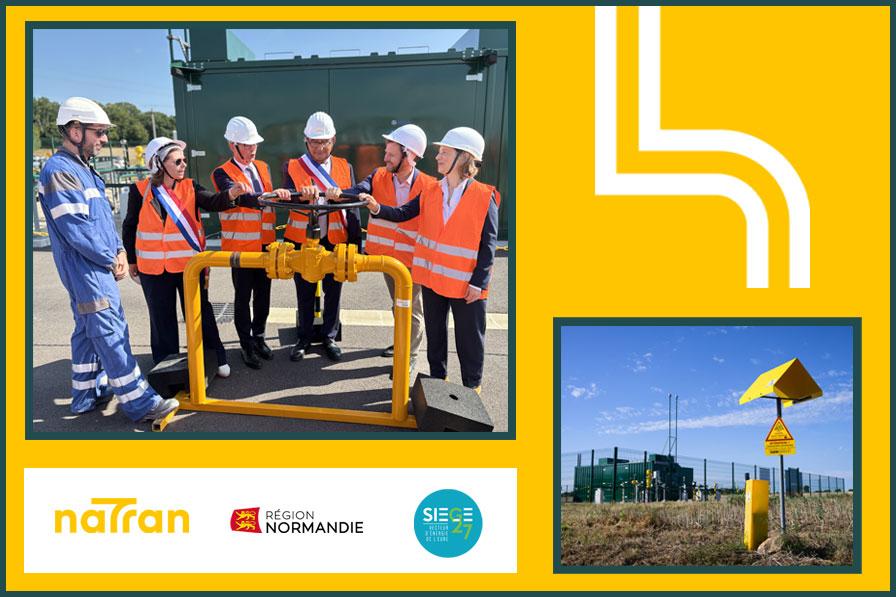Mandres reverse-flow opened in the Eure department

On 18 July 2025, the Mandres reverse-flow facility (Eure) was officially opened in the presence of Michel Osmond, Mayor of Mandres, Céline Heidrecheid-Rousseau, Director of Renewable Gases at NaTran, and Xavier Hubert, Chairman of SIEGE 27.
Innovative management of the gas system
Innovative management of the gas system to support regions and industries in their decarbonisation process
At the border between the gas transmission network and the gas distribution network, the reverse-flow station allows surplus biomethane production to be channelled into NaTran pipelines when it cannot be consumed locally. In particular, this technology makes it possible to meet the challenges posed by seasonal consumption, by transferring surplus biomethane production to other areas of consumption.
A facility to support the development of renewable gases
3 biogas production units, located in Saint-Symphorien-des-Bruyères, Breteuil and Saint-Sulpice-sur-Risle, benefit from the Mandres reverse-flow facility.
79.3 GWh of renewable gas are produced, equivalent to the consumption of around 19,700* new homes or 310** buses running on bioNGV. This represents a 38% share of renewable gas in the annual gas consumption of the Normandie Sud Eure intermunicipality and the Pays de l’Aigle Community of Communes.
By 2030, this rate will have risen to 73%.
The investment amounts to €2.6 million, co-financed by the Normandy Region and SIEGE 27, each contributing €100,000 towards the project studies.
*1 TWh (terawatt-hour) corresponds to one billion kilowatt-hours (KWh). On average, a household consumes
10,000 kWh per year.
** 1 megawatt-hour (MWh), equivalent to 1,000 kilowatt-hours (KWh)
*Consumption basis: 4 MWh per home, corresponding to the consumption of a new home
Normandy: the leading region in France in terms of number of active reverse-flows
Normandy, a region conducive to the development of renewable gas and the leading French region in terms of the number of active reverse-flow facilities
Normandy has a total of 64 injection biogas production units in service, representing 1.3 TWh of production capacity, equivalent to the consumption of around 311,000 homes*. In addition, 136 projects are currently registered in the capacity register (+15% compared with the end of 2023).
The Eure department contributes to the regional dynamic, with 9 injection biogas production units in service, producing 175 GWh/year of biomethane, equivalent to the consumption of 41,000 new homes.
Normandy is the leading region in France in terms of the number of active reverse-flow facilities: Argentan (61), La Ferté-Macé (61), Ceton (61), Saint-James (50) and Mandres (27). The region’s agricultural resources, combined with GRDF’s extensive distribution network, make it an ideal location for the development of biogas production. The introduction of reverse-flow stations has an essential role to play in supporting this dynamic.
In addition to the reverse-flow facilities already in service, Normandy has several other projects in the pipeline:
- 4 reverse-flow stations are under construction: Coutances (50), Saint-Hilaire-du-Harcouët (50), Alençon (61) and Le-Pin-la-Garenne (Orne).
- 3 reverse-flow stations are being studied: Nassandres-sur-Risle (27), Sainte-Cécile (50) and Fécamp (76)
- A further 5 reverse-flow facilities are planned for commissioning in 2027/2028.
The Mandres project is part of an inter-operator planning process between NaTran and GRDF, designed to anticipate changes to the network and support the development of biomethane in Normandy.
Biogas production, a local, renewable energy source
Biogas production is a technology for the local production of renewable gas that contributes to the circular economy, decarbonisation and energy sovereignty of our region, while supporting the agricultural sector.
This process produces biomethane, a 100% renewable gas, from the fermentation of organic matter from agricultural by-products and waste.
Once it has been purified, it can be injected into gas networks for use in the same way as natural gas for households (heating, cooking, etc.), for industry, or for low-carbon mobility by being used as a fuel for vehicles and HGVs. This 100% renewable fuel is known as bioNGV.
As well as producing 100% renewable and local energy, the biogas production process generates digestate, a residue that can be used as an organic fertiliser, thus reducing the need for chemical fertilisers.